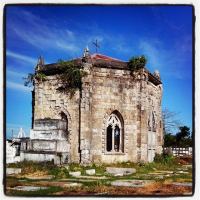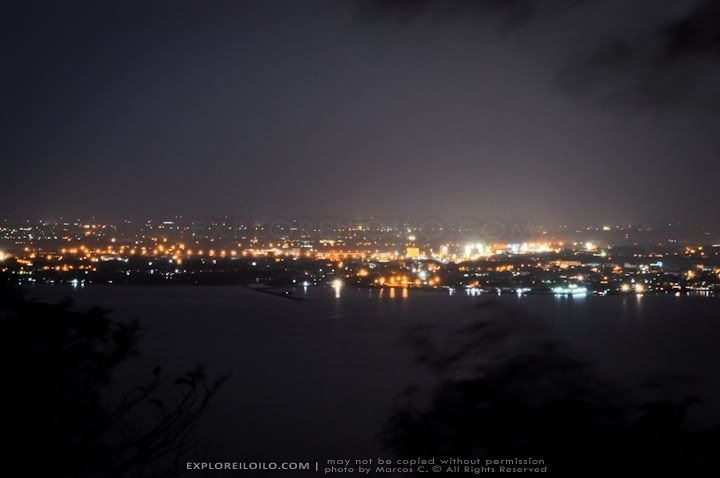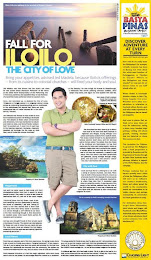It’s All-Souls Day and as a heritage advocate, I opted to post seven historical mortuary chapels here in my province. As the Iloilo slogan states, “Where Past is Always Present”, these chapels are great evidence of how Ilonggos keep its history. I believe that no other province in the Philippines has this great number of well-preserved historical structures, particularly its Campo Santo or the Mortuary Chapel (feel free to correct and email me if I am wrong.
Take note these are all my personal bias. Please bear with me.
 Top 7: It is Beautiful but is Lost! This is the story of Miagao’s Campo Santo. Though it’s far better than the others, I placed this at number seven since the structure has collapsed and was not rehabilitated anymore. Perhaps, they can rebuild this since as far as I know some of its parts are just kept on one side. We all know that Miagao has UNESCO Heritage Church and this should be preserved as well since the two are connected. Based on some scripts, the chapel is made of bricks which is considered as the best feature of this chapel. The earthquake in 2013 has totally damaged the structure, though prior to this quake, some posts have been rotten due to its adage. If only reconstructed, I do believe this chapel can be placed on my top three.
Top 7: It is Beautiful but is Lost! This is the story of Miagao’s Campo Santo. Though it’s far better than the others, I placed this at number seven since the structure has collapsed and was not rehabilitated anymore. Perhaps, they can rebuild this since as far as I know some of its parts are just kept on one side. We all know that Miagao has UNESCO Heritage Church and this should be preserved as well since the two are connected. Based on some scripts, the chapel is made of bricks which is considered as the best feature of this chapel. The earthquake in 2013 has totally damaged the structure, though prior to this quake, some posts have been rotten due to its adage. If only reconstructed, I do believe this chapel can be placed on my top three.
 Top 6: Missing the Proof! If you’ll dig the pictures of the Old Oton Church you will be surprised at how magnificent it is. If only rehabilitated, it would be the most beautiful church in the Philippines. On the contrary, it is not what you expect from it’s Campo Santo, it is just a plain and simple mortuary. But kudos to the people who preserved this edifice, still the latest generation has a chance to see this small piece of heritage. It was believed that Fray Demetrio Cobos (1844-1854) was the head in establishing the Oton Church and maybe the cemetery as well. But when compared to others, it really lacks artistry and sophistication. The famous line “Sa Dios magdayao ang manga tol-an sang mga nagpaobus sining cabuhi” can be seen on its wall. This is number 6 on my list as it is still visible.
Top 6: Missing the Proof! If you’ll dig the pictures of the Old Oton Church you will be surprised at how magnificent it is. If only rehabilitated, it would be the most beautiful church in the Philippines. On the contrary, it is not what you expect from it’s Campo Santo, it is just a plain and simple mortuary. But kudos to the people who preserved this edifice, still the latest generation has a chance to see this small piece of heritage. It was believed that Fray Demetrio Cobos (1844-1854) was the head in establishing the Oton Church and maybe the cemetery as well. But when compared to others, it really lacks artistry and sophistication. The famous line “Sa Dios magdayao ang manga tol-an sang mga nagpaobus sining cabuhi” can be seen on its wall. This is number 6 on my list as it is still visible.
 Top 5: Never Gone for Good. Pototan like Oton, also lost its historical church. Good thing its campo santo is still standing tall. Though there was an issue on the replaced roof, the exterior remains intact. Pototan, like other places, is challenged by rapid urbanity. The cemetery’s entrance archway is made of limestone. The date 1894 – probably the inauguration date–is found above the iron gates. According to UPV professor Joy Rosal Sumagaysay in her 1995 thesis, “Octagonal in shape, the capilla has three segmented-arch openings. The plain and simple exterior walls are redeemed by the squat triangular pediments which crown all eight sides of the capilla. This unique architectural design serves as the accent to the original dome roofing of the capilla”. Right for the top 5!
Top 5: Never Gone for Good. Pototan like Oton, also lost its historical church. Good thing its campo santo is still standing tall. Though there was an issue on the replaced roof, the exterior remains intact. Pototan, like other places, is challenged by rapid urbanity. The cemetery’s entrance archway is made of limestone. The date 1894 – probably the inauguration date–is found above the iron gates. According to UPV professor Joy Rosal Sumagaysay in her 1995 thesis, “Octagonal in shape, the capilla has three segmented-arch openings. The plain and simple exterior walls are redeemed by the squat triangular pediments which crown all eight sides of the capilla. This unique architectural design serves as the accent to the original dome roofing of the capilla”. Right for the top 5!
 Top 4: Deep in the Woods! The charming interior Municipality of Dingle is famous for so many things such as Moroboro Dam and the Camp Pasica. But the way they preserve their heritage is another thing that one should look up to. Their church is well-preserved, but I guess their cemetery chapel should be restored and taken care of to restore its glory. Similar to other chapels, the doors and windows are lancet-shaped curved out of exquisite stone foundation with wood carvings. Dingle has a great source of limestone which in fact this town is the source of limestone used to build other chapels such as that of Janiuay. The chapel is made of limestone with a detailed cross at the entrance. The artistic carve represents Ilonggos craftsmanship. The number four spot is all yours.
Top 4: Deep in the Woods! The charming interior Municipality of Dingle is famous for so many things such as Moroboro Dam and the Camp Pasica. But the way they preserve their heritage is another thing that one should look up to. Their church is well-preserved, but I guess their cemetery chapel should be restored and taken care of to restore its glory. Similar to other chapels, the doors and windows are lancet-shaped curved out of exquisite stone foundation with wood carvings. Dingle has a great source of limestone which in fact this town is the source of limestone used to build other chapels such as that of Janiuay. The chapel is made of limestone with a detailed cross at the entrance. The artistic carve represents Ilonggos craftsmanship. The number four spot is all yours.
 Top 3: Making the Presence Felt: The municipality of Janiuay is famous for its cemetery’s facade. The stairs leading towards the tombs is well-preserved and impossible not to see every time you passed by this area. Built in 1884, Janiuay cemetery has three grand staircases lead and supported by a retaining wall. The Gothic-styled octagonal mortuary chapel or capilla is the crowning glory of the cemetery. Like other chapels, it has also a lancet-shaped doors and windows as well as exquisite stone and wood carvings. A life-size stone statues used to line the entrance. Though the Church in the town has been abandoned, this mortuary is still usable. This has a resemblance with that of Cabatuan mortuary, so for now, number 3 is the right place.
Top 3: Making the Presence Felt: The municipality of Janiuay is famous for its cemetery’s facade. The stairs leading towards the tombs is well-preserved and impossible not to see every time you passed by this area. Built in 1884, Janiuay cemetery has three grand staircases lead and supported by a retaining wall. The Gothic-styled octagonal mortuary chapel or capilla is the crowning glory of the cemetery. Like other chapels, it has also a lancet-shaped doors and windows as well as exquisite stone and wood carvings. A life-size stone statues used to line the entrance. Though the Church in the town has been abandoned, this mortuary is still usable. This has a resemblance with that of Cabatuan mortuary, so for now, number 3 is the right place.
 Top 2: Black is Beautiful… Cabatuan’s mortuary is stunning especially during the afternoon when the sun rays strike the structure. As you enter the cemetery, the three Byzantine arch entrances along the main highway welcome you. The candle tree-lined path towards the octagonal mortuary chapel is appealing with an artistically-designed steel railing. The façade has detailed carvings. Inside the chapel is a crucifix, a simple altar and the 12 tombs. Built of gray stone, the Cabatuan cemetery was established by Fr. Juan Porras and it is the only extant Spanish cemetery in the Philippines that is a perfect square. The entire cemetery is a combination of Roman, Gothic, Byzantine, and Baroque architectural influences, worthy for number two spot isn’t it?
Top 2: Black is Beautiful… Cabatuan’s mortuary is stunning especially during the afternoon when the sun rays strike the structure. As you enter the cemetery, the three Byzantine arch entrances along the main highway welcome you. The candle tree-lined path towards the octagonal mortuary chapel is appealing with an artistically-designed steel railing. The façade has detailed carvings. Inside the chapel is a crucifix, a simple altar and the 12 tombs. Built of gray stone, the Cabatuan cemetery was established by Fr. Juan Porras and it is the only extant Spanish cemetery in the Philippines that is a perfect square. The entire cemetery is a combination of Roman, Gothic, Byzantine, and Baroque architectural influences, worthy for number two spot isn’t it?
 Top 1: The Best is Down Under! San Joaquin’s great asset is number one for me. This southernmost municipality of Iloilo has preserved its heritage. Both the church and cemetery are standing great and were designated as a National Cultural Treasure by the National Museum of the Philippines last December 2015. Fr. Mariano Vamba was the Augustinian priest who established this structure in 1892. Built on top of the hill of about 20-stone steps, the mortuary chapel is baroque-style architecture. It is made of white coral rocks and fossil stones with red dome caps. A beautiful replica of the iconic La pieta statue found inside the chapel. Entering the place reminds you of how holy this place is. The statues of Christ and the holy saints are located everywhere while overlooking the blue Sulu sea. Such splendid place which every visitor needs to visit.
Top 1: The Best is Down Under! San Joaquin’s great asset is number one for me. This southernmost municipality of Iloilo has preserved its heritage. Both the church and cemetery are standing great and were designated as a National Cultural Treasure by the National Museum of the Philippines last December 2015. Fr. Mariano Vamba was the Augustinian priest who established this structure in 1892. Built on top of the hill of about 20-stone steps, the mortuary chapel is baroque-style architecture. It is made of white coral rocks and fossil stones with red dome caps. A beautiful replica of the iconic La pieta statue found inside the chapel. Entering the place reminds you of how holy this place is. The statues of Christ and the holy saints are located everywhere while overlooking the blue Sulu sea. Such splendid place which every visitor needs to visit.
Iloilo is a rich province in terms of heritage preservation. Churches and capillas (mortuary chapel or campo santo) can be seen anywhere particularly in those Spanish-established towns. Though some has been lost, the effort conducted by different stakeholders is visible as seen on the different more-than-century-old structures. Social Media’s influence in providing information on heritage conservation is the catalyst for today’s generation. It’s good to know that the game is not yet over. We can still create our micro-efforts to preserve what is left with us, perhaps public information is the first step. Not just to remember during the special occasion but always if possible.
P.S. Happy Halloween! Have you already visited your loved ones or they will visit you?
===
REPOST FROM: https://fredjrzabala.wordpress.com/2021/10/31/the-seven-camposanto-mortuary-chapel-of-iloilo-philippines/

















